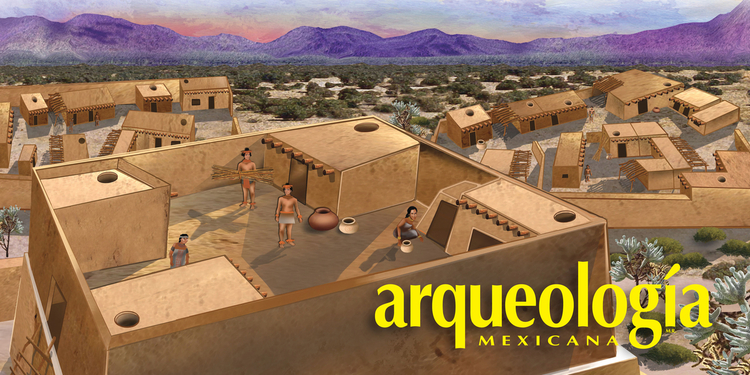
It is only in higher-value, lower-quantity artifact classes that hints appear: Hohokam shell jewelry, a Hohokam cotton garment, and other things of that nature appear at Chaco Canyon. The timing of their respective histories – Chaco's burst of major building commenced about 1020 CE while Hohokam's decline began about 1000 CE – suggests a historical linkage, but there is little material evidence of sustained interaction. Obviously, the Southwest's two biggest cultures of the 9th-12th century CE knew each other. The great civilization ended around 1450 CE, perhaps in a class revolt of the commoners against the platform mound rulers (as recalled in Native stories).

The new regime was marked by new pottery: a striking, colorful new type, Gila polychrome, appeared in large quantities alongside the older types. On the flat upper surface of these mounds stood the substantial adobe homes of a new Hohokam leadership – prior to the platform mounds, archaeology has not revealed any evidence of an elite. These rectangular earth-filled structures reached sizes of 50 m by 95 m, standing over 7 m tall. A new form of public architecture appeared platform mounds. Ball-courts, previously the center of civic life, were no longer built or even used. Hohokam peaked at about 900 CE, but after 1000 CE, it shrank back into its original core area in the Phoenix Basin. Obviously, the Southwest's two biggest cultures of the 9th-12th century CE knew each other, but there is little material evidence of sustained interaction.

Huge canal systems on the Salt and Gila Rivers (channeling waters from the Mogollon uplands) underwrote its thousand-year history. At Chaco and throughout the Four Corners, rainfall farming was (barely) possible, but in the Hohokam deserts – with far less precipitation – farming absolutely required irrigation. SL: Hohokam civilization comes into focus around 500 CE they prospered along the major rivers of the deserts of southern Arizona, 500 km (311 miles) from the Four Corners and Chaco Canyon. Is there evidence of significant cultural or material exchange between the Hohokam and the Ancestral Puebloans, and how should we characterize their unique role and legacy in the Southwest? The Hohokam constructed impressive settlements, sophisticated irrigation canals, and even built ritual ball-courts that mirror those found in Mesoamerica. JBW: The Hohokam, who lived in present-day Arizona, distinguish themselves from their neighbors by virtue of the longevity of their culture. Chaco's nobles may have moved south toward fellow nobles in Mesoamerica, and helped to found Paquimé ( Casas Grandes), the Southwest's last great city. Droughts and violence led ultimately to the abandonment of the Four Corners region by tens of thousands of Ancestral Pueblo people most of whom moved to join the modern Pueblos, from the Hopi Pueblos in Arizona on the west, through Zuni and Acoma, to the many Pueblos of the Rio Grande in New Mexico in the east. About 1090 CE, the capital shifted north to Aztec Ruins National Monument, but the new capital could not maintain the peace and prosperity of Chaco's reign. It is likely that the unique Pueblo social structures arose in reaction and rejection of the hierarchies of Chaco, which ended badly. Pueblos are famously egalitarian – they have no nobles, kings or capital city.

Modern Pueblo people are descendants of Chaco and Mesa Verde, but they conspicuously avoid the kinds of hierarchies and wealth and social class evident at Chaco.

Recent research shows that vast quantities of goods were brought into Chaco Canyon, the capital, even from a great distance and the central noble family of Pueblo Bonito (the largest of the palaces) was a matrilineal dynasty that lasted several centuries. Chaco Canyon is the site of a half-dozen Great Houses – monumental sandstone structures of up to 500 rooms, that rose up to five stories and covered over one hectare of area.įor many years Great Houses were considered exceptionally nice farming villages, but it is becoming more and more likely that they were palaces for a nobility that ruled over up to 60,000 commoners, in a region of 100,000 square kilometers (38610 square miles), encompassing such famous sites as Mesa Verde, Hovenweep, and Canyon de Chelly. SL: Perhaps the most important new development in our understanding of the Ancestral Pueblo (Anasazi) peoples of the Four Corners (the area around the joint corners of Colorado, Utah, Arizona, and New Mexico) is the pivotal role of Chaco Canyon, the 11th-century CE regional center in northwestern New Mexico.


 0 kommentar(er)
0 kommentar(er)
